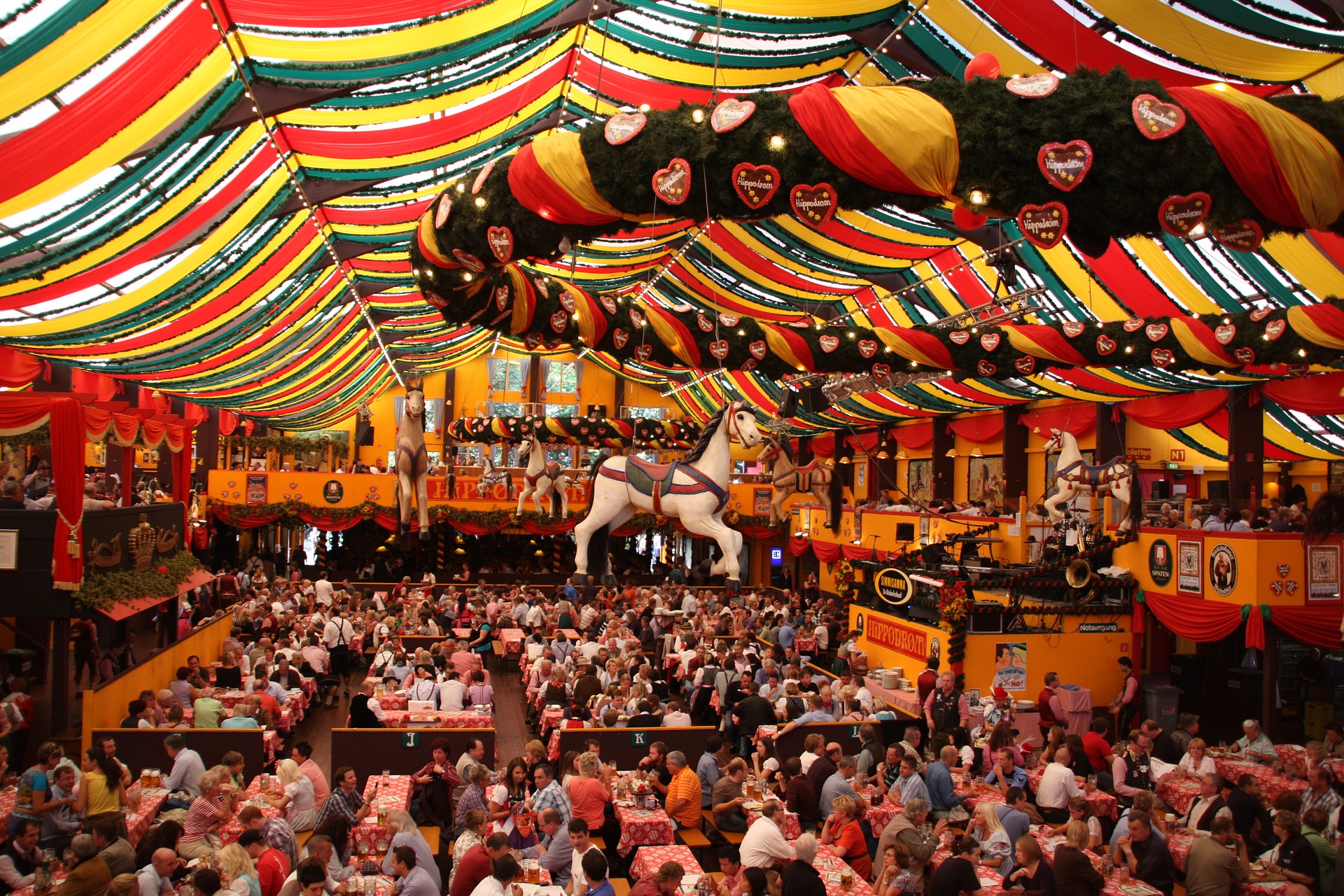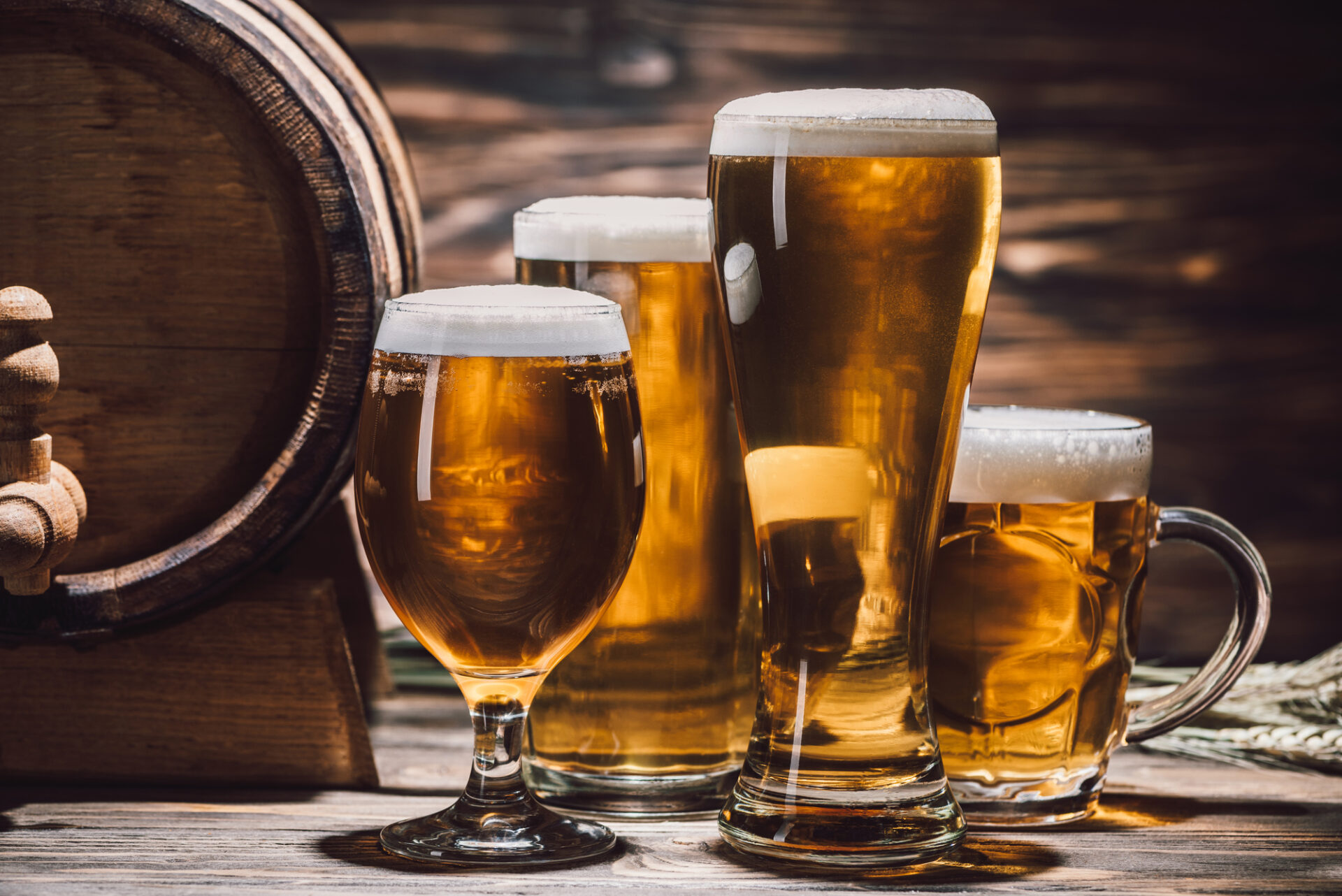The first thing many people think of when you say “Oktoberfest” is a big German party with people swinging large stein glasses of beer as they drink, oompah bands, buxom serving wenches, and men in lederhosen.
However, despite being a large annual party (which is actually in September, not October), Oktoberfest is a seasonal beer style also. And although it originates from Germany, it is now brewed everywhere, including here in the US.
If you have never tried an Oktoberfest beer, you don’t know what you are missing out on! Although many American Oktoberfest-style beers differ from their German counterparts, they all share the same story — and virtually the same ingredients.
Oh, and if you’re looking to try one for the first time — be quick, as traditionally these beers are only around for a month or two and are rarely served after the fall!
The Origins of Oktoberfest
Oktoberfest is known worldwide as the world’s largest beer festival dating back to the 19th century. Today, over 6 million visitors consume over 2 million gallons of beer in Munich over the two week period of the festival.
To understand where Oktoberfest beer comes from, you first need to understand a little of the history of the Oktoberfest public festival.
The very first Oktoberfest was a five-day party held in Munich to celebrate the wedding of Crown Prince Ludwig of Bavaria to Princess Therese von Sachsen-Hildburghausen. (Wow, you almost need a beer just to pronounce those names!)

Image by Lutz Krüger on Pixabay
Like all good five-day parties, it was very popular with the locals who quickly adopted it to become an annual celebration.
Although there were many tents serving the incredible, delicious beers we now associate with Oktoberfest, it wasn’t until 1818 that booths were introduced serving both food and drinks. These quickly became the large beer hall-style tents made of plywood popularized by 20th-century Oktoberfests.
What Beer Is Served at Oktoberfest?
The original beer served at the very first Oktoberfest was a dark lager similar to a German Dunkel.
Well-kilned malts such as Munich malt were used at the very beginning of the 19th century by German breweries, but as brewing technology and techniques developed, paler beers were introduced.
Beers for Oktoberfest were actually brewed in March — due to the summer temperatures being too high to brew — and left to mature or lager in cooler underground caves for up to six months in preparation for the fall.
Rather than using dark malts that produced more copper in color and malty lagers, northern European brewers were using air-dried malts and raw grains to produce lighter lager beers.
By the 1870s, lighter European beers were becoming much more popular, and in 1872, Josef Sedlmayr introduced the lighter style of Vienna lager at the annual Oktoberfest.
The Vienna lagers sold very well and very quickly, with most Marzen (German for “March,” when the beer was brewed) beers quickly adopting the style using paler malts — and the Oktoberfest beer style was born.
Only six breweries, however, are officially allowed to serve at the Oktoberfest in Munich properly :
- Hofbrau
- Spaten
- Paulaner
- Lowenbrau
- Augustiner
- Hacker Pschorr
Of all these breweries, Augustiner is the oldest, founded in Munich in 1328. The youngest brewery of the big six is Paulaner which served its first beers in 1634.
As you can see, Oktoberfest breweries are some of the oldest in the world and steeped in history, just like this incredible German-style beer.
What Does an Oktoberfest Beer Taste Like?
Although there are many brands of Oktoberfest beer available, they are all very drinkable, yet rich, beers.
The first thing you will notice is the incredible clarity of the beer along with a slightly amber color which ranges from copper hues to more golden hints in some of the more modern paler varieties.

Image by holzijue from Pixabay
Despite being a lager, rich malt notes dominate with some vaguely toasty notes and a bread flavor. With a really dry finish, the beer is only slightly bitter due to the presence of noble hops. But with an IBU of less than 25, on average, it will be much less bitter than most other German lagers like a pilsner.
A relatively high ABV of 6% for a lager makes it friendly to drink, but maybe in smaller quantities than a session beer or traditional lager.
The big Munich Six all feature slightly different flavor profiles, with some like Paulaner Oktoberfest Marine adding hints of spiced banana and a lemon hop to the general sweet flavor. One of my favorites would be the Hacker-Pschorr Brau Original Oktoberfest which uses lightly toasted malts for a nutty flavor and a fruity and floral hop aroma.
What Are the Key Ingredients in an Oktoberfest Beer?
Just what is it that gives Oktoberfest beers that amber color, slight sweetness, excellent clarity, and muted bitterness with a rich toasty malt flavor?
If you want to truly experience an Oktoberfest-style beer, you will need ingredients of German origin.
The Malt
Perhaps the most important factor in making a robust beer like an Oktoberfest is the malt.
For a true German-style Oktoberfest beer or Marzen, you will need to source malts from Germany. Fortunately nowadays in the US, you can get prime German grains like Pilsner or Munich from many reputable maltsters.
Generally, Oktoberfest beers in Munich will use Pilsner and Munich malt which give the beer its deep golden color and a taste of maltiness.
Other malts which are often added to the brew include:
- Acidulated (Sauermalz) malt can help control the pH levels of the mash
- German light crystal
- Melanoidin malt
- German dark crystal
- British caramel malt
American craft breweries often substitute more caramel malt in their Oktoberfest beer blend which gives the beer more of a sweet caramel-like flavor.
Although American-style Oktoberfest brews don’t have the same hop-malt balance as their German cousins, they do tend to be sweeter and easier to drink.
The Hops
Oktoberfest beers are not particularly hoppy beers, They mainly add a balance to the rich malt flavors of the beer.
A typical brew will only need 1 to 3 ounces of hops to achieve a low IBU. It would be best if you were looking for an IBU of between 18 and 25 for Oktoberfest beers, much lower than a Pilsner style lager or an IPA.
German noble hop varieties are the go-to hops for Oktoberfest, especially the following:
- Saaz
- Tettnanger
- Hershbrucker
- Hallertau Mittelfruh
From my past experiences, Hallertau hops are the ideal hop for getting a flavorsome Oktoberfest beer.
The Yeast
Being a lager rather than an ale, it is an Oktoberfest beer that uses a bottom-fermenting lager yeast namely Saccharomyces pastorianus to give the full Latin name. A yeast with low attenuation will help leave a sweet aroma while also bringing out those bready malt hints.
Many yeast producers now have strains that are specially bred for Oktoberfest brews including Omega Oktoberfest, White Labs Oktoberfest lager yeast< RVA Yeast Labs Oktoberfest Lager and Wyeast Oktoberfest Lager blend to name but a few.
How Strong Are Oktoberfest Beers?
The average ABV of an Oktoberfest beer usually falls between 5.1% to 6%.
The official breweries of the Oktoberfest beers in Munich have beers that are mostly 6% or more with the exception being Hacker-Pschorr coming in at 5.8%.
German purity laws dictate that every Oktoberfest beer should have a minimum of 13.5% Stammwurze which translates to at least 6% ABV.
Oktoberfest beers are stronger because of their longer lagering period. Traditionally brewed in March, the 6-month layering allows the beer to reach its peak ABV by September. However, today’s Oktoberfest beers are also brewed to a higher gravity which again results in a stronger beer with higher alcohol by content level.
German beers in general are much stronger than their American counterparts, so although an American Oktoberfest beer version may still be strong, it won’t be as strong as a Paulaner, Spaten, or any of the other big six Munich beers.
The Different Types of Oktoberfest Beers
Not all Oktoberfest beers are the same!
If we are just talking about the Munich Oktoberfest beers then these are all the same as they are brewed under very strict German Purity laws known as the Edict of Purity which was passed over 500 years ago.

Photo by Kurt Liebhaeuser on Unsplash
The association of Munich brewers has even registered Oktoberfest as a trademark and dictates these Munich beers are only allowed to be served during the Oktoberfest festival to preserve the Munich origin of this exceptional beer.
It gets complicated with the American versions of Oktoberfest beers, which hark back to the darker and sweeter Oktoberfest beer style originally brewed in Munich rather than the lighter beers served today.
American vs German Oktoberfest Beers
American beer creativity has produced Oktoberfest beers which are much sweeter and don’t feature as much hop-malt balance as the German beers. More caramel malt in the beer lends a much sweeter flavor.
In addition, a shorter lagering period means an American Oktoberfest beer doesn’t have the same clean, crisp profile as a German-style lager and also has a lower ABV.
That’s not to say some American breweries haven’t failed to notice these differences and make Oktoberfest beers which bear more resemblance to the batch beers served at modern Oktoberfests.
In a strange twist of fate, some German brewers have also noticed the difference in the American flock of beer styles and now export American-style Oktoberfest beers back to the US beer lovers.
To try and help clarify matters the Brewers Association breaks down the Oktoberfest category into two clear classifications: German-Style Oktoberfest/Wiesn and American-Sale Oktoberfest/Marzen.
Next time you are in your favorite American craft tap room, ask which type of Oktoberfest beers they are serving. Many American Oktoberfest tests are now held across the US, in particular, you will find an exciting beer market for Oktoberfests at Colorado Craft Beer Festival every September.
To sample Oktoberfest beers in their purest form you really should try and visit the Munich Oktoberfest and try the big six Munich beers along with millions of other international beer enthusiasts.
Food Pairings With an Oktoberfest Beer
Traditionally Oktoberfest should be drunk from a stein beer glass or mug and accompanied by some German beer snacks like soft pretzels, sausages with sauerkraut, sauerbraten, and pork schnitzels.
You’ll notice all these things have one thing in common – salt! The sweetness of an Oktoberfest beer quickly balances the meat and carbs’ savory qualities.
The mild sweet profile of Oktoberfest beer also makes for an interesting counter taste to many of the more acidic meals like tomato-based Italian pasta dishes.
Oktoberfest Beers: The Conclusion
Oktoberfest beer is an incredible German-style beer that I believe every beer lover should try at least once. Although it is only available seasonally, it is now an international beer which doesn’t mean having to visit Munich.
Oktoberfest beers are well known globally, mainly due to the beer festival which shares its name. While attending the Munich Oktoberfest can be a challenge for many beer lovers, many of our favorite local craft breweries now put on their tests in mid-September to early October with a selection of locally produced Oktoberfest beers or Marzens.
If you want to brew your own Oktoberfest beer, just try to ensure you use German-origin ingredients for a more authentic taste. Many are now available in your local brew supplies depot and there are plenty of recipes for Oktoberfest beers out there.
Whichever type of Oktoberfest beer you choose, just enjoy it for what it is – it won’t be around long, just one to two months of the year normally so Prost and enjoy!

